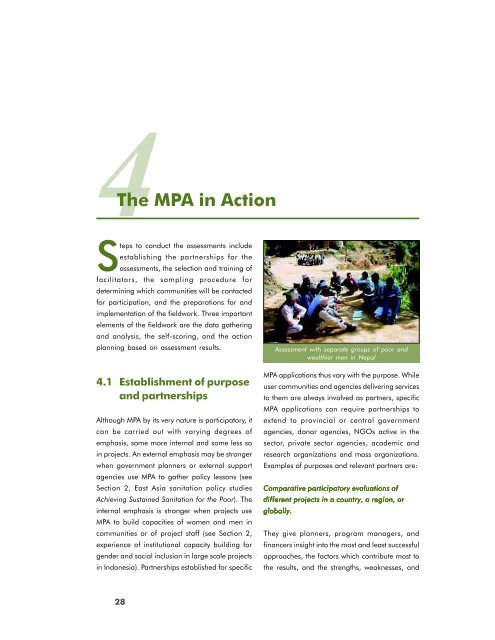Sustainability Planning and Monitoring
Sustainability Planning and Monitoring
Sustainability Planning and Monitoring
- No tags were found...
You also want an ePaper? Increase the reach of your titles
YUMPU automatically turns print PDFs into web optimized ePapers that Google loves.
THE MPA IN ACTION4The MPA in ActionSteps to conduct the assessments includeestablishing the partnerships for theassessments, the selection <strong>and</strong> training offacilitators, the sampling procedure fordetermining which communities will be contactedfor participation, <strong>and</strong> the preparations for <strong>and</strong>implementation of the fieldwork. Three importantelements of the fieldwork are the data gathering<strong>and</strong> analysis, the self-scoring, <strong>and</strong> the actionplanning based on assessment results.4.1 Establishment of purpose<strong>and</strong> partnershipsAlthough MPA by its very nature is participatory, itcan be carried out with varying degrees ofemphasis, some more internal <strong>and</strong> some less soin projects. An external emphasis may be strongerwhen government planners or external supportagencies use MPA to gather policy lessons (seeSection 2, East Asia sanitation policy studiesAchieving Sustained Sanitation for the Poor). Theinternal emphasis is stronger when projects useMPA to build capacities of women <strong>and</strong> men incommunities or of project staff (see Section 2,experience of institutional capacity building forgender <strong>and</strong> social inclusion in large scale projectsin Indonesia). Partnerships established for specificAssessment with separate groups of poor <strong>and</strong>wealthier men in NepalMPA applications thus vary with the purpose. Whileuser communities <strong>and</strong> agencies delivering servicesto them are always involved as partners, specificMPA applications can require partnerships toextend to provincial or central governmentagencies, donor agencies, NGOs active in thesector, private sector agencies, academic <strong>and</strong>research organizations <strong>and</strong> mass organizations.Examples of purposes <strong>and</strong> relevant partners are:Comparative participatory evaluations ofdifferent projects in a country, a region, orglobally.They give planners, program managers, <strong>and</strong>financers insight into the most <strong>and</strong> least successfulapproaches, the factors which contribute most tothe results, <strong>and</strong> the strengths, weaknesses, <strong>and</strong>28
















